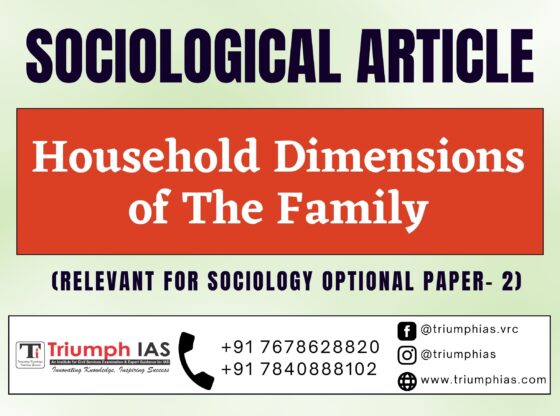Household Dimensions of The Family
Relevant for sociology optional Paper- 2 (Unit- 12 : Social Structure)

In India, the family has always been considered as a vital unit of society. It is a social institution that is given great importance in Indian culture, and it plays a crucial role in shaping the individual’s life. The concept of a family is not limited to a group of people living together under one roof but encompasses a wide range of relationships, roles, and responsibilities that are shared by the members of the family. Household dimensions of the family, therefore, refer to the various aspects of the household, such as its structure, functions, and dynamics that contribute to the overall well-being of the family.
One of the primary household dimensions of the family in India is its structure. The structure of the family in India is largely influenced by the patriarchal system, which gives the father or the eldest male member of the family a dominant role in decision-making. The joint family system, which is prevalent in many parts of India, is a good example of the patriarchal family structure. In a joint family, several generations of a family live together, and the elder members exercise authority over the younger ones. The nuclear family, which consists of parents and their children, is another prevalent family structure in India. In recent years, with the growth of urbanization and the emergence of the nuclear family, the joint family system has been losing its popularity. However, in rural areas, the joint family system still prevails as it provides economic and social security to its members.
The household dimension of the family also encompasses the functions of the household. The functions of the household include the provision of shelter, food, clothing, and other basic necessities of life. In many Indian households, women are primarily responsible for household functions such as cooking, cleaning, and taking care of children. In joint families, the workload is shared among the members, and each member contributes according to their abilities. In recent years, with the entry of women into the workforce, there has been a significant shift in the division of labor within the household. Women now contribute to the household income, and men are expected to participate in household functions such as cooking and cleaning.
The household dimension of the family also includes the dynamics of the household. The dynamics of the household refer to the relationships, roles, and interactions between the members of the family. In Indian households, there is a clear hierarchy of authority, with the eldest male member of the family being at the top. The relationships between the members of the family are based on mutual respect and deference to elders. In joint families, the relationships between the members are complex and require a delicate balance of power and authority. Conflicts and disagreements are inevitable in any family, but in Indian households, they are often resolved through dialogue and negotiation.
Another critical aspect of the household dimension of the family in India is the role of the family in the socialization of its members. The family plays a vital role in shaping the values, beliefs, and behaviors of its members. Children learn from their parents and other family members the social norms and customs of their community. The family also teaches the importance of respect, responsibility, and obedience to elders. In Indian households, the education and upbringing of children are given great importance, and parents take an active interest in their children’s academic and extracurricular activities.
Religion also plays a significant role in the household dimension of the family in India. India is a country with diverse religious beliefs and practices, and the family often serves as a primary agent of religious socialization. Religious festivals and rituals are an essential part of Indian family life, and they provide an opportunity for family members to come together and celebrate their faith. In many households, the family priest or guru plays an important role in the religious life of the family.
The household dimension of the family in India is also closely tied to the economic dimension of the family. In many households, economic activities are carried out within the family, and the family serves as a primary economic unit. In rural areas, agriculture is often the primary source of income for the family, and family members work together in the fields. In urban areas, small businesses and shops are often run by the family, and family members take on different roles and responsibilities. The family also provides a safety net for its members during times of economic hardship, and family members often support each other financially.
In conclusion, the household dimension of the family in India is a complex and multifaceted concept that encompasses various aspects of the family’s structure, functions, and dynamics. The family plays a crucial role in shaping the individual’s life and is an integral part of Indian culture. While the traditional joint family system is losing popularity in urban areas, it still remains prevalent in rural areas, and the family continues to serve as a primary social, cultural, and economic unit. Understanding the household dimension of the family is essential for understanding the dynamics of Indian society and its cultural values.
For more such free UPSC notes, Articles, News & Views Join our Telegram Channel. https://t.me/triumphias
Click the link below to see the details about the UPSC – Civils courses offered by Triumph IAS. https://triumphias.com/pages-all-courses.php


